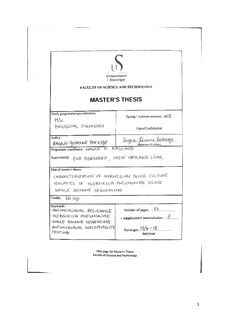| dc.contributor.author | Bakksjø, Ragna | |
| dc.date.accessioned | 2018-10-15T09:17:16Z | |
| dc.date.available | 2018-10-15T09:17:16Z | |
| dc.date.issued | 2018-06 | |
| dc.identifier.uri | http://hdl.handle.net/11250/2567965 | |
| dc.description | Master's thesis in Biological chemistry | nb_NO |
| dc.description.abstract | The increasing trend of antimicrobial resistance (AMR) has been acknowledged by the world health organization (WHO) as an urgent threat to public health. Especially the development of multi drug resistant (MDR) Gram-negative bacteria with resistance to last-line antibiotics are of great concern.
Klebsiella pneumoniae is a gram-negative enterobacteria often linked to AMR and is by WHO considered to be one of the most “critical pathogens” in need of research and development of new effective antibiotics.
As an addition to susceptibility testing for AMR surveillance, whole genome sequencing (WGS) provides more knowledge of resistant strains, such as content of resistance genes and genotypes of disseminating of resistant strains.
In this thesis, a population of K. pneumoniae isolates (n=243) provided by NORM, was characterized in regard to species, sequence type and resistance genes. The genotypic data was compared to phenotypic results from antimicrobial susceptibility testing was also compared.
In the investigated K. pneumoniae population, the dominating subspecies was K. pneumoniae sensu stricto. Among all isolates a variety of sequence types (STs) were identified. The most commom STs were ST20 (n=14), ST25 (n=10), ST1114 (n=8), ST10 (n=7), ST307 (n=6), ST37 (n=6), ST515 (n=6), ST14 (n=5) and ST35 (n=5). A total of 29 isolates were identified as genotypic and phenotypic ESBL positive; 28 isolates characterized as ESBLA, where blaCTX-M-15 was the most prevalent beta-lactamase encoding gene. One isolate was found to inhabit an ESBLCARBA encoding gene (OXA-48), as well as an ESBLM encoding gene (CMY-4). Multi drug resistance was found in 29 isolates (regardless of ESBL) meaning that they confer resistance to three or more antibiotic drug classes (beta-lactams, aminoglycosides, fluoroquinolones and/or trimethoprim/sulfametoxazole)
It was concluded that next-generation sequencing along with antimicrobial susceptibility testing was a good method for genotypic determination of the population structure and AMR determinants in a K. pneumoniae population. | |
| dc.language.iso | eng | nb_NO |
| dc.publisher | University of Stavanger, Norway | nb_NO |
| dc.relation.ispartofseries | Masteroppgave/UIS-TN-IKBM/2018; | |
| dc.subject | biologisk kjemi | nb_NO |
| dc.subject | antimicrobial resistance | nb_NO |
| dc.subject | klebsiella pneumoniae | nb_NO |
| dc.subject | whole genome sequencing | nb_NO |
| dc.subject | antimicrobial susceptibility testing | nb_NO |
| dc.title | Characterization of Norwegian blood culture isolates of Klebsiella pneumoniae using whole genome sequencing | nb_NO |
| dc.type | Master thesis | nb_NO |
| dc.subject.nsi | VDP::Matematikk og Naturvitenskap: 400::Kjemi: 440 | nb_NO |
| dc.subject.nsi | VDP::Matematikk og Naturvitenskap: 400::Basale biofag: 470::Biokjemi: 476 | nb_NO |
